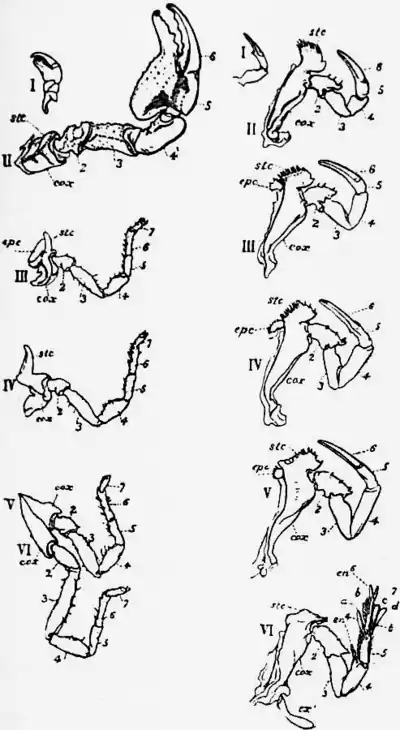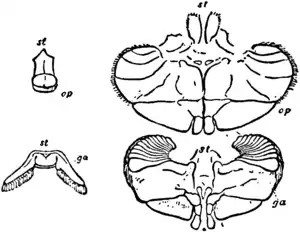ARACHNIDA
291
the true limitations of the cerebrum, whilst embryological researches have done as much for Scorpio. Limulus thus agrees with Scorpio and differs from the Crustacea, in which there are three prosthomeres—one ocular and two carrying palpiform appendages. It is true that in the lower Crustacea (Apus, &c.) we have evidence of the gradual movement forward of the nerve-ganglia belonging to these palpiform appendages. But although in such lower Crustacea the nerve-ganglia of the third prosthomere have not fused with the anterior nerve-mass, there is no question as to the prae-oral position of two appendage-bearing somites in addition to the ocular prosthomere. The Crustacea have, in fact, three prosthomeres in the head and the Arachnida only two, and Limulus agrees with the Arachnida in this respect and differs from the Crustacea. The central nervous systems of Limulus and of Scorpio present closer agreement in structure than can be found when a Crustacean is compared with either. The wide divarication of the lateral cords in the prosoma and their connexion by transverse commissures, together with the “attraction” of ganglia to the prosomatic ganglion group which properly belong to hinder segments, are very nearly identical in the two animals. The form and disposition of the ganglion cells are also peculiar and closely similar in the two. (See Patten (42) for important observations on the neuromeres, &c., of Limulus and Scorpio.)
 | |
| Fig. 12.—The prosomatic appendages of Limulus polyphemus (right) and Scorpio (left), Palamnaeus indus compared. The corresponding appendages are marked with the same Roman numeral. The Arabic numerals indicate the segments of the legs. | |
| cox, Coxa or basal segment of the leg. | ex1, The exopodite of the sixth limb of |
| stc, The sterno-coxal process or jaw-like | Limulus. |
| up-growth of the coxa. | a, b, c, d, Movable processes on the |
| epc, The articulated movable outgrowth | same leg (see for some suggestions |
| of the coxa, called the epi-coxite | on the morphology of this leg, |
| (present only in III of the scorpion | Pocock in Quart. Journ. Micr. Sci. |
| and III, IV and V of Limulus). | March 1901; see also fig. 50 below |
| and explanation). | |
(From Lankester, loc. cit.)
 |
| Fig. 13.—Diagrams of the metasternite st, with genital operculum op, and the first lamelligerous pair of appendages ga, with uniting sternal element st of Scorpio (left) and Limulus (right). (From Lankester, loc. cit.) |
- ↑ See fig. 12 in the article Arthropoda.
- ↑ Though ten is the prevailing number of retinula cells and rhabdomeres in the lateral eye of Limulus, Watase states that they may be as few as nine and as many as eighteen.